Pedalling With Every Need
- By Juili Eklahare and Sharad Matade
- July 14, 2022
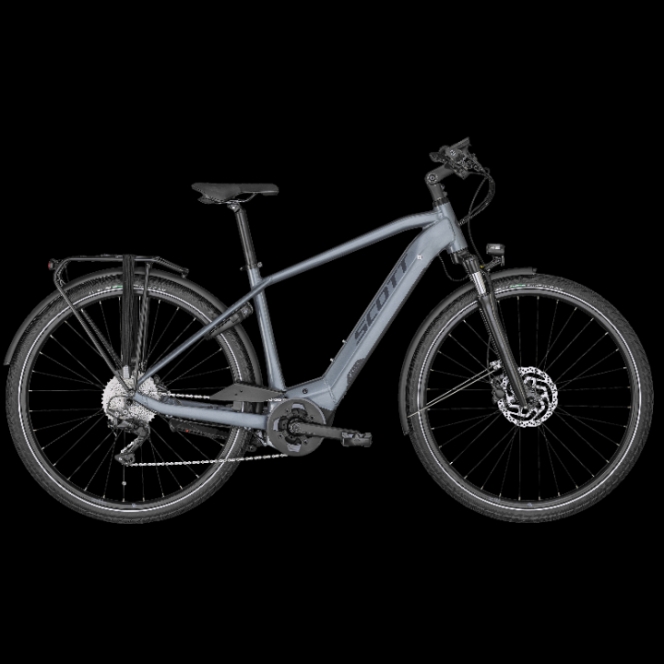
The bicycle industry has seen an exponential demand, especially since the Covid-19 pandemic hit. With an increase in commodity prices and new players entering the industry, every manufacturer has to be as efficient as possible to make its bicycle stand out in the market. We talk to Scott Sports India on making its place in the Indian market, the impact of the pandemic and investing in its customers.
The increase in the purchasing power of consumers in developing nations like India, Mexico and Malaysia is anticipated to be the utmost driver for the bicycle market in the years to come. Also, according to a recent study, the global bicycles market is expected to reach USD 78 billion by 2026, especially with so many bicycle players making their way into the market.
One such company is Scott Sports, a Swiss producer of bicycles, winter equipment, motorsports gear and sportswear, which has also made its place in India. Working towards the development, manufacturing, sales and marketing of high-end performance products intended for biking, the company’s agenda is to get more and more people out on bicycles, cycling outdoors. When the company started off in India, a large part of its customers was, in fact, people from the IT sector. These people had travelled across the world on projects, realising that there is a lifestyle that one can have and that there are bikes that one can buy which actually cater to this lifestyle, giving one a better riding experience. However, as time has gone by, the company has had customers right from a 12- or 13-year-old kid to an 85-year-old gentleman, ever since it started its journey in India in 2012. It currently has about 110 outlets and with the Avanti Giro FM1 brand coming in, it is planning to add another 150 outlets in the next 12 months.
Bikes suitable for anyone and everyone
Scott Sports introduced Avanti Giro FM1 from New Zealand recently in India, making it suitable for southern hemisphere countries. “In the southern hemisphere, largely, there exists a lot of commute and price-sensitive customers, from India to South Africa to Brazil to Australia etc.,” says Jaymin Shah, Managing Director, Scott Sports India, and continues, “That entire belt of countries consists of sports, but at the same time, is very sensitive to price. Therefore, at the end of the day, they want products that are designed for a particular reason, that can do the work and don’t burn a big hole in their pockets. This is why we launched the Avanti brand, which also lets us reach out to a bigger target audience that is India.”
But introducing a bike for the southern hemisphere is not the company’s only unique element. Scott Sports, till it entered the business, realised that bicycles are available in a one-size-fits-all kind of a category. What Scott Sports did was get the same bicycle in different frame sizes. “Just the way you can buy a shirt in a small, medium, large or XL size, the same can be done with bicycles,” Shah reveals and adds, “This is a change that the Indian customer did not know about (about a decade back).”
Another element that Scott Sports focuses on is called ‘bike fit’. Shah explains, “Bike fit is a concept where one can customise the dimensions on one’s bike. The frame size remains the same, but it has a different leg length, torso length and so on.”
Shah further informs, “We have a system and a software, along with a German partner, where the system scans your body and makes recommendations as per the model you want to select.”
A broken helmet is a good helmet
Customisation or no customisation, one factor that people surely look for in any vehicle, including bicycles, is safety. Catering to this need, we see many bicycle brands offering helmets or other safety features. Scott Sports’ bikes come equipped with reflectors, which are mandatory. “Along with this, we sell a lot of products as accessories, like helmets, reflector vests or even reflector stickers,” Shah asserts. Pointing out a very interesting aspect about helmets, he further tells us, “While the core idea of a helmet is to protect the bicycle rider, many people think that the helmet should not break when they crash. However, the fact is that if the helmet does not crack after a severe crash, then the helmet in question is of a sub-standard variety. A good helmet will crack. This is because the crack is what dissipates the fall and distributes the impact.”
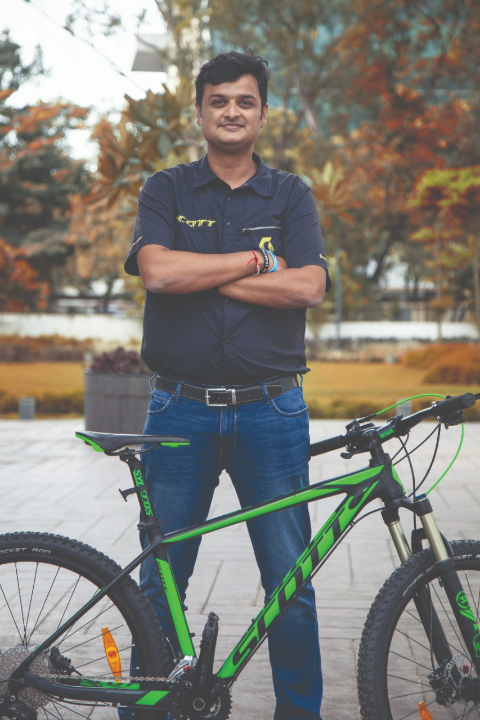
Increase in commodity prices
Scott Sports is currently catering to three segments – lifestyle, commute and sports. Shah believes that the sports and lifestyle segments will see growth. “On the commute side, we have suddenly seen a drop in bicycles, only because cars are back on the streets,” he tells us.
As these segments see growth, prices too will be a factor of consideration. All of Scott Sports’ bicycles are made of alloy and carbon. However, general commodity prices, which include aluminium alloy etc., have seen an increase in price. From Scott’s perspective, the demand has not been impacted for one reason alone – the consumer/target audience not looking for the mass market. “They are looking for premium products,” Shah says and continues, “Only time will tell if this is sustainable or not, because a point may come where the consumer will say that he/she is not willing to pay beyond that price. Plus, global shipping rates have gone through the roof, i.e. by five times, which is huge. Scott has also increased the prices of its products in India from 1st April this year.”
Shah goes on to mention that the government is doing all it can to cool off commodity prices. “However, I don’t think it all can be controlled by just one government measure. That’s because there are a lot of factors which are beyond our control, from the Russia-Ukraine war to the Covid situation. And this applies not just to India but the world,” he cites.
One material is as durable as the other
On the material front, he clarifies that whether a bicycle is made of steel, alloy or carbon, the product is a durable one. What’s important is that it has to be maintained well. “The biggest difference between an alloy and a steel bike or an alloy and a carbon bike is the weight of the bicycle. Steel bicycles typically tend to be heavier than alloy bicycles and carbon bicycles tend to be lighter than alloy bicycles. One is as durable as the other,” he explains.
Educating the customer and mechanics
With the customers’ demand and needs changing rapidly, educating them and making them aware becomes highly crucial. Scott Sports has some singular initiatives in this domain. For one, it has a customer helpline number that is not a sales helpline but simply a customer education helpline. “One can call the helpline and talk to our product specialists who will guide the customer through various factors,” Shah avers.
Another initiative it has is ‘breakfast rides’ (conducted mainly pre-covid). “We used to conduct breakfast rides with small communities across the country, where our product specialists would address one topic,” Shah puts across and adds, “The topic could be with respect to customer education, bike maintenance, bike fit and would vary in every ride. Also, with everything sort of opening up post-covid, we will be restarting these breakfast rides.”
Scott Sports invests not just in its customers but in its mechanics as well. It runs ‘technical services’ meant for trade only and for all the mechanics. “Here, either our team would go out to a regional centre and call in the mechanics nearby or the mechanics would come to Mumbai,” Shah informs and adds, “This is something we used to do on a regular basis to sensitise the mechanics.”
Covid’s impact on business
Post the lockdown, Scott Sports has grown by 100 percent. “In that sense, it was a great year from a business perspective. However, we also realise that there is a lot of demand out there,” Shah shares.
While it was a smooth-running chain pre-covid, each country had to be subject to its own lockdowns post-covid, as per their respective government’s measures. “So now, all our bikes come from Cambodia, but a lot of components come from Vietnam or Malaysia or Indonesia. It’s not just about putting a bicycle together – it’s about getting all the moving parts, from the tyres to tubes to suspensions, together. So, from that perspective, tying everything together from different parts of the world became a challenge for us,” Shah enlightens.
Challenges for the industry
With these challenges, we can’t remove the competition out of the equation, especially with new companies entering the market. Nonetheless, Shah claims that at the price-point and quality level where Scott Sports is, it is equivalent to a BMW or a Mercedes or an Audi today. “You can buy a product which is priced at INR 40,000 but also buy a Scott bike which is priced at INR 1 million,” he says and goes on, “The mass brands, we hear, are in over-stocked situations, which is also contributed by so many players entering the market. However, when one looks at the premium market – that we are targeting and have been historically present in – no overnight player can really come in and challenge us over there.”
However, there are other challenges to face. The Indian government’s restriction on import of tyres and tubes has impacted the bicycle owners the most, Shah believes. He asserts that there are local manufacturers for automobile tyres. However, on the bicycle front, with the level of quality required for international brands, the importers requiring such tyres are facing the biggest challenge.
The next step
Scott Sports sold over 12,000 units during the financial year 2021-2022. Speaking of the company’s targets for the current fiscal, Shah tells us, “Our target is not more than 15,000 next year. This is essentially not a reflection of the demand but a reflection of how many bikes we can get into the country.”
Catering to every personalised requirement
The bicycle industry certainly is seeing tremendous demand and is evolving every day, especially where every consumer gets to choose a bike that suits him/her the best. This, of course, comes with its share of challenges for the industry and customers both. For a market like India, where customers can be price-sensitive and some also willing to invest in bicycles, making them aware goes a long way, catering to their every personalised requirement that they look for when purchasing a bicycle.
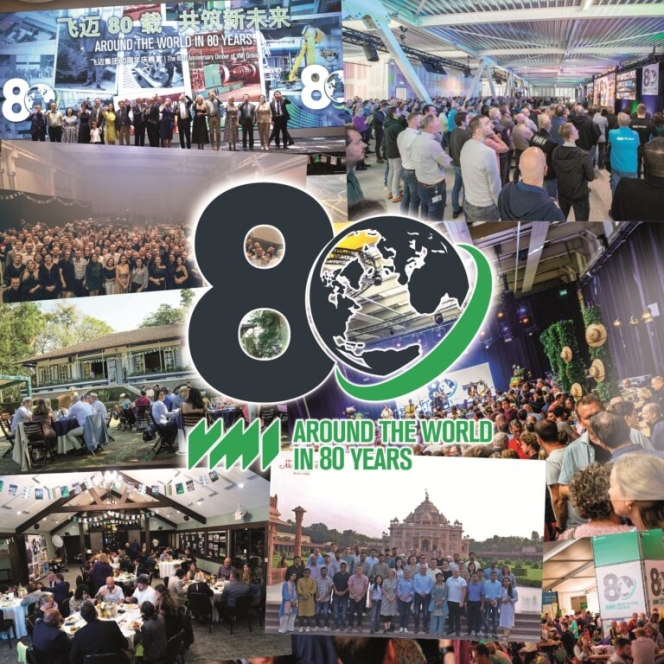
The year 2025 marked a significant chapter for VMI Group as it celebrated 80 years of operation, highlighting a landmark achievement for the international manufacturing firm. The company, which began as a modest workshop in Gelderland, Netherlands, has evolved into a worldwide operation serving the tyre, rubber and related industries across multiple continents.
The anniversary year was structured around the theme ‘Around the World in 80 Years’, featuring a series of celebratory events at major global facilities. Activities commenced with a virtual gathering connecting the entire organisation on 1 April. This was followed by large-scale in-person events in key locations including Yantai, China; Stow, United States; Itatiaia, Brazil; Leszno, Poland; and Vadodara, India. A particular highlight was a Family Day in Epe, Netherlands, which drew participation from over 3,000 employees and their family members.
The extensive campaign served not only to highlight the company's global scale but also to honour the collective contributions of its workforce. The celebrations were framed as a tribute to the employees and their families whose efforts over eight decades have shaped the company's unique and inclusive culture.
Underpinning the anniversary recognition is the company's longstanding commitment to innovation. Throughout its history, VMI has emphasised research and development, driving its growth with a continuous pipeline of new products designed for its global customer base.
Adding to the year’s milestones, VMI also received a gold EcoVadis award in 2025. This recognition underscores its standing as a leader in sustainability and environmental responsibility within the manufacturing sector.
Harm Voortman, CEO, VMI, said, “VMI is a global business, but we are also truly local in every country where we operate. We pride ourselves on being professional, rigorous and always working to the highest standards but also welcoming, open and friendly to everyone.”
Mike Norman, Chief Commercial Officer, VMI, said, “This great milestone has been reached and VMI is already looking forward to new challenges, new achievements and more celebrations- with innovation as the key to success in the future, just as it has been for the past 80 years.”
CEAT’s Road Ahead Sustainability, Scale And A Five-Year Innovation Roadmap
- By Nilesh Wadhwa
- December 15, 2025
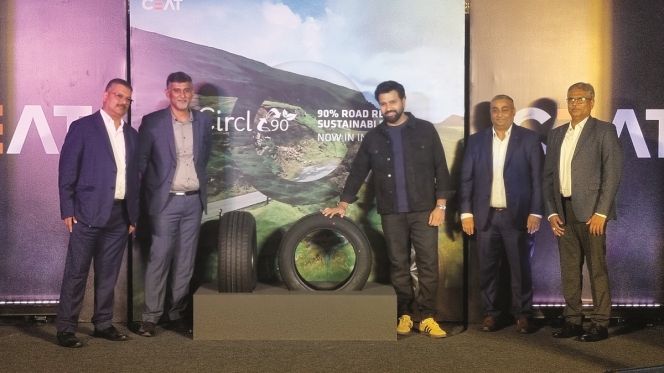
With a series of new product launches aimed at meeting diverse needs, CEAT aims to target new set of customers who are looking beyond just cost.
Mumbai-based RPG Group’s flagship company CEAT, one of India’s most recognisable tyre brands, is at the cusp of a transformation. From being known for durability and value-for-money tyres, the company is repositioning itself as a technology and sustainability leader – offering products that don’t just meet performance benchmarks but also embody environmental responsibility.
The company recently launched SecuraDrive CIRCL, a limited-edition road-ready tyre with up to 90 percent sustainable materials. This feat makes the company one of the few global players to have introduced sustainable tyre that is just not a concept but a ground reality.
For CEAT, the immediate priority is to educate consumers about sustainable tyres. With the launch of the SecuraDrive CIRCL, available in limited numbers (264 tyres), it is taking a deliberate step to spark conversations around eco-conscious choices.
Lakshmi Narayanan B, Chief Marketing Officer, CEAT Tyres, told Tyre Trends, “The first piece is customers becoming aware. This isn’t just a conceptual product – it absolutely matches the performance of a conventional tyre. The idea is to give consumers a clear-cut option and an opportunity to buy into the philosophy of sustainability.”
The company has introduced two variants for the CIRCL range – Circle 50 (50 percent sustainable content) and Circle 90 (90 percent sustainable content). The limited-edition approach, according to CEAT, is intentional. “We want consumers to make a conscious choice to understand the value of sustainability in a product they use daily,” he added.
The focus, then, is not only on selling a product but on creating a new mindset. As Lakshmi Narayanan B put it: “This is as much a product story as it is a brand story. We want consumers buying into it for the right reasons.”
FROM CONCEPT TO MANUFACTURING REALITY
While many companies experiment with prototypes or pilot runs, CEAT insists that its CIRCL tyres are not small-scale experiments. Instead, they are proof of manufacturing readiness at scale.
“When you can make 264 tyres using 90 percent sustainable content, you have the capability to scale it up to any number,” said Lakshmi Narayanan B, pointing to the three years of dedicated work on CIRCL within CEAT’s broader five-year innovation journey. “This is not a pilot run – it’s literally scale manufacturing. What you see today is the outcome of years of work,” shared Lakshmi Narayanan B.
The company has also leveraged its past innovations – such as run-flat tyres and CALM technology – to strengthen manufacturing processes. “Each innovation adds capability. Whether it is sourcing sustainable materials or manufacturing in a new way, we’re now confident of handling such things at scale,” he explained.
For CEAT, scale is not just about numbers but about readiness. “We have proven that sustainability and performance can co-exist. And when consumer interest builds, we are absolutely ready to scale this into mainstream adoption,” Lakshmi Narayanan B added.
EMBEDDING SUSTAINABILITY ACROSS VALUE CHAIN
The tyre major recognises that sustainability cannot be restricted to a single product line – it must cut across the entire value chain. Renji Issac, Senior Vice President – R&D and Technology, CEAT Tyres, pointed out that CIRCL is only the beginning. “All the learnings from this programme will flow into circular product development, extended producer responsibility (EPR) and end-of-life tyre management. Sustainability doesn’t stop at manufacturing – it extends to what happens after the product’s lifecycle,” said Issac.
This approach also means working closely with suppliers, including MSMEs and startups, to adopt new processes and materials. “Initially there was resistance; why should they change (suppliers)? But over time, they have seen the opportunity. Today, our entire supplier ecosystem is committing to our sustainability goals. It’s a challenge but also a transformation,” averred Lakshmi Narayanan B.
Issac added that part of CEAT’s role has been to handhold startups developing new materials, helping them scale their innovations into market-ready solutions. “Some of these materials come from startups, and it’s not just about us developing the product. We are helping them bring their products to market,” he explained.
This ecosystem development is crucial because CEAT believes that innovation is only as strong as its supply chain. “It’s not only about what we make in-house but how the entire chain contributes to sustainability,” said Lakshmi Narayanan B.
A STRUCTURED FIVE-YEAR ROADMAP
Looking ahead, CEAT is guided by a five-year roadmap that balances near-term launches with long-term capability building.
Issac explained that CEAT has developed “a very firm two-year plan on products that will hit the market. Beyond that, the next three years are about developing enabling technologies. For every product roadmap, there’s also a technology roadmap and a capability roadmap. This ensures we’re not just reacting to the market but anticipating it.”
This structured approach allows CEAT to introduce innovations faster while preparing for regulatory and consumer shifts globally.
Lakshmi Narayanan B stressed that the company wants to stay ahead of the curve. “Our intent is to be proactive, not reactive. Whether it’s a current trend or a future wave, we want to be in the right place at the right time,” he said.
The roadmap is part of CEAT’s larger R&D strategy, which has already delivered multiple first-to-market products in recent times. “Run-flat tyres, 21-inch ZR rated tyres, CALM technology and now the sustainable tyre – all of these are stepping stones in our long-term direction,” Lakshmi Narayanan B explained.
GLOBAL RELEVANCE WITH INDIAN CONSUMER FOCUS
Although CEAT operates in global markets, the company deliberately chose India as the first market for CIRCL. The rationale is clear: while European demand is often regulation-led, CEAT sees India as a consumer-driven opportunity.
“In Europe, sustainability is often about regulation. In India, we want it to be a conscious consumer choice. That’s why we launched here first – we know Indian consumers are asking these questions, especially EV owners and younger buyers. It’s an early adopter segment, but it will grow,” shared Lakshmi Narayanan B.
The CIRCL tyres will initially be available in 8–10 metros, targeting discerning consumers with compact SUVs and EVs. The company acknowledges that the products come at a premium but insists the value proposition lies in sustainability with uncompromised performance. “The promise is clear: sustainability and performance equal to any conventional tyre,” Lakshmi Narayanan B emphasised.
Looking forward, the company believes the CIRCL project positions it strongly for future regulatory shifts worldwide. “With capabilities like this, we can leapfrog in global markets when the time comes,” Lakshmi Narayanan B noted.
From CIRCL’s limited-edition launch to a broader five-year innovation pipeline, CEAT’s future focus revolves around three pillars:
1. Consumer-first sustainability – creating awareness and demand among discerning buyers, particularly EV owners.
2. Ecosystem transformation – enabling suppliers, startups and partners to align with CEAT’s sustainability vision.
3. Structured innovation roadmap – delivering near-term product launches while building long-term capabilities.
As Issac summed it up: “A sustainable tyre is also a low rolling resistance tyre. There’s no conflict between sustainability and performance. In fact, they move in the same direction.”
“It’s a long game, but we’re happy to take the first step. Future is always bright,” concluded Lakshmi Narayanan B.
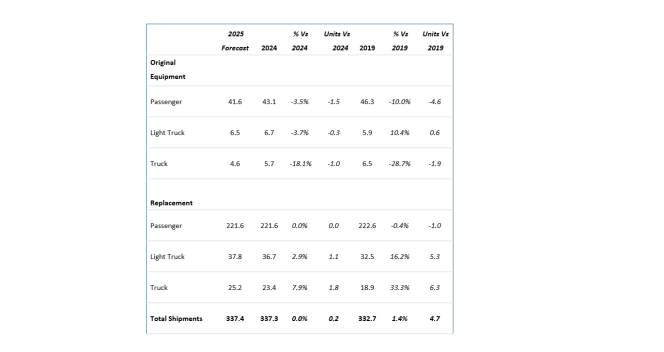
The US Tire Manufacturers Association (USTMA) expects total US tyre shipments to reach 337.4 million units in 2025, marginally above the previous record of 337.3 million units set in 2024 and up from 332.7 million units in 2019.
The association noted that the forecast was prepared without August and September trade data, which were delayed by the US government shutdown. It said this may result in higher-than-usual estimation errors for replacement tyre shipments.
Original-equipment shipments of passenger, light truck and truck tyres are projected to fall by 3.5 percent, 3.7 per cent and 18.1 percent respectively in 2025, a combined decrease of 2.8 million units compared with 2024.
Replacement shipments are expected to remain flat for passenger tyres, rise by 2.9 per cent for light truck tyres and increase by 7.9 percent for truck tyres. Total replacement shipments are forecast to grow by 3.0 million units.
Trelleborg Tires Named Best Agricultural Tyre At Visão Agro Brazil Awards
- By TT News
- December 12, 2025
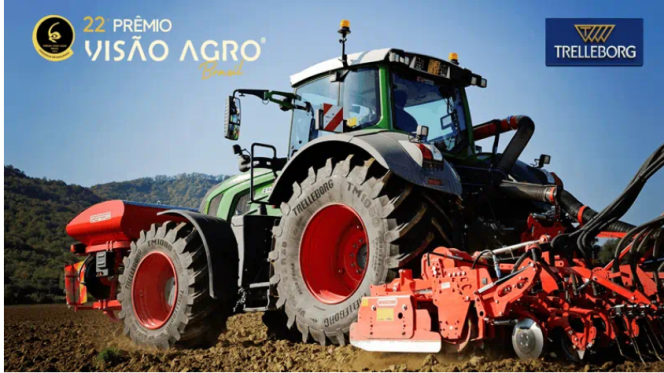
Trelleborg Tires has been named “Best Agriculture Tire” at the 22nd Visão Agro Brazil Awards, held in Ribeirão Preto, São Paulo, on 4 December. The award recognises the company’s focus on technological development and its contribution to sustainable growth in Brazil’s agricultural sector.
The trophy was accepted by Fábio Metidieri, Agri Sales Director at Yokohama TWS Brasil. Metidieri said the accolade strengthened the company’s commitment to Brazilian farming and reinforced the value of its investment in product innovation, field validation and local expertise.
Trelleborg is expanding the use of its ProgressiveTraction technology across its TM range, from the TM600 for row-crop applications to the TM1000 for high-horsepower tractors. The design employs a dual-edge lug intended to improve traction, self-cleaning and vibration levels, supporting efficiency, tyre longevity and soil protection.
“Receiving this award at such a prestigious event once again reinforces our commitment to Brazilian agriculture,” Metidieri said. “Our goal is to keep advancing in technology and field performance, ensuring that every Trelleborg tire delivers real value — helping farmers operate more efficiently, sustainably, and profitably.”
The company maintains a local technical team, conducts extensive field testing and works with well-established OEM partners in major farming regions. This proximity, Metidieri said, helps ensure that tyre development reflects the practical demands of Brazilian agriculture. “This award reflects the trust placed in our team and our products by professionals throughout the sector. It strengthens our commitment to delivering technologies that address local challenges and help shape the future of Brazilian farming.”
The Visão Agro Brazil Awards recognise suppliers and innovators across the national agribusiness sector. A jury of executives, researchers and decision-makers assess companies on innovation, sustainability and performance.







Comments (0)
ADD COMMENT